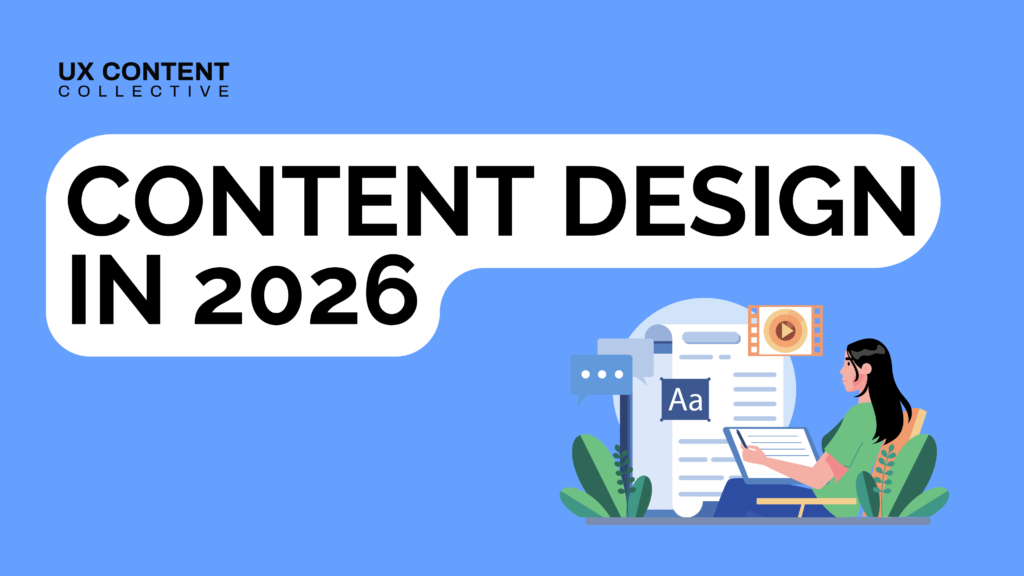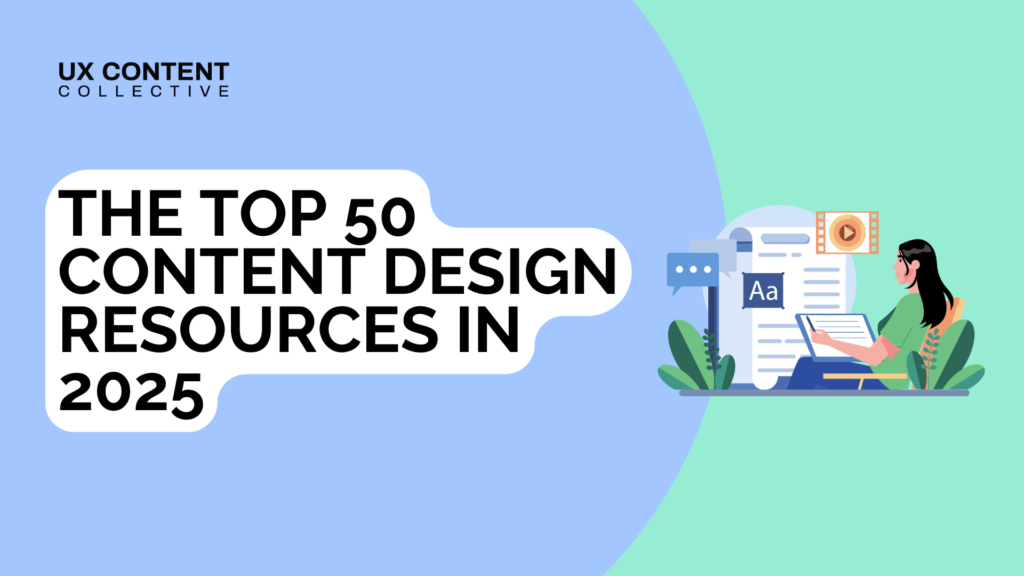
Why content designers need to understand business goals

Patrick Stafford

Ready to advance your UX content skills?
Take the next step for content designers and UX writers: enroll in Advanced UX Content for Product.

This post is an excerpt from our course, Advanced UX Content for Product.
When content designers are early in their careers, most of the work happens at the surface layer. You’re brought into projects during design, asked to polish strings, tighten flows, and make sure the interface reads well. And you do that work well.
But understanding UX business goals is crucial to going beyond that surface-level work.
We’re not going to mislead you: everyone working in an organization is going to be subject to decisions made by people you don’t know. But that doesn’t mean you can’t wield greater influence over those decisions.
If you want to have impact—real impact at the product level—you need to understand how products work, and that means you need to understand how organizations work. Otherwise, you’ll just keep running into the same roadblocks again, and again, and again.
What is a business system?

Business system is a made-up term that we’re using to just describe everything that happens to make “the business” run: make money, allocate resources, and so on. Organizations are a complex web of priorities, incentives, goals, and internal processes that shape every decision, including what content gets built, what features are prioritized, and which problems are seen as worth solving.
Even non-profit organizations and governments have business principles at play. They may not be seeking a profit, but they still operate like businesses to ensure their sustainability.
The business receives signals like user behavior, market shifts, leadership directives, and individuals within that system decide where to respond. If customer acquisition slows, people pour energy into marketing and onboarding. If churn rises, retention and activation become the priority. If support costs spike, usability and guidance content rise to the top of the roadmap.
If the industry shifts towards artificial intelligence, money flows into engineering rather than design.
If you’re not tuned into the way the business processes those signals, your work might be excellent but it won’t be seen as essential.
Most of the time, your business system is invisible to you. Decisions get made behind closed doors. Priorities shift without warning. And unless you actively seek context, you’re left responding to decisions you didn’t get to influence.
To counter that, you need to be curious about how your company earns revenue, where it spends money, how it tracks success, and what it’s trying to achieve in the future.
Why UX business goals matter for content designers
You’re a senior content designer working on the company’s core product: a subscription platform with multiple tiers and add-ons. The PM asks you to review the cancellation flow—the goal is simple: reduce churn.
At first, it looks like a familiar project. You tighten some error messages, add clarity around downgrades, and suggest a few save attempts. That’s valuable work but familiar territory. As you explore the flow, you notice a bigger pattern: users trying to cancel are doing so right after hitting feature restrictions in the mid-tier plan. (This would probably be noticed by a product manager first… but let’s roll with it for now.)
You start asking broader questions:
- Which features trigger the most upgrades or downgrades?
- How does lifetime value differ between product tiers?
- What’s the margin on each plan and how does support load vary?
- Is churn actually the highest-value problem to solve here?
Lifetime value is a metric businesses often use to describe how much they expect customers to spend over a certain period of time.
Now, many content designers struggle to get their hands on a lot of financial data. But let’s say you get your hands on some. In digging through the data, you discover:
- The mid-tier product generates the most churn, but also carries the lowest profit margin due to high support volume.
- The premium tier, while smaller in volume, contributes a higher percentage of revenue and lifetime value especially when users adopt advanced analytics features.
- Users canceling from the mid-tier often cite confusion or unmet expectations—especially around those premium-adjacent features.
You propose a new approach: rather than trying to “save” churn in the mid-tier, restructure the upgrade flow to better onboard high-potential users directly into the premium tier. You recommend:
- Revising mid-tier positioning to focus on clear upgrade paths
- Introducing messaging that clarifies premium value earlier in the user journey
- Replacing the generic cancellation flow with a branching experience that guides users toward higher-margin alternatives—not just retention for its own sake
You back it up with business impact:
- Improving onboarding into the premium tier by just 3% could generate $2.1M in annual recurring revenue at far lower support cost
- Repositioning support investment around high-margin customers offers better ROI than blunt-force churn reduction in a low-margin segment
You’ve taken a request to polish a cancellation flow and used it to influence how the company invests in product tiers, structures its revenue strategy, and scopes future experiments.
How to understand the business system
Okay, we get it. You’re a content designer, not a product manager. You don’t want to think about this.
And that’s fair enough. Our goal isn’t to say that you need to think about the business system at every single point in your work and at 100% capacity. You’re not a product manager, after all. The answer is to pick and choose when you care about it, when you use it, and when you go digging for more data. Even just a basic understanding goes a long way.
How does your company make money?
It sounds obvious, but many product teams operate without a shared understanding of what drives revenue, what costs money, and what the business is optimizing for right now. Without that lens, it’s easy to do great content work that solves the wrong problem or solves the right problem, but in the wrong place.
What’s the business model?
Is your company selling:
- Subscriptions?
- One-time purchases?
- Ads or sponsorships?
- A freemium product with paid upgrades?
- A service layered on top of a tool?
In a subscription model, retention is king. In freemium, onboarding is critical. In services, clarity drives trust and reduces support costs. These priorities will have some impact on the user experience even on very granular concepts, like hierarchy or character constraints.
What are the key product lines?
What does the business actually sell? Where are the growth bets, and which products are in maintenance mode? Understanding where your product sits in the portfolio helps you decide where to push and where to let go.
What are the high-margin features or customers?
Not all revenue is created equal. High-margin products or customer segments (e.g. enterprise plans, long-term subscriptions) might justify deeper investment in infrastructure, onboarding, or personalization. That’s where a well-structured content system can pay off and where your work can influence not just UX, but profitability.
What are the business goals this quarter? This year?
This should guide your prioritization. Are you in a growth phase? A consolidation phase? Is the company trying to expand into new markets? Reduce churn? Increase upsells? If your content work doesn’t map to a known priority, it’s more likely to be deprioritized no matter how good it is.
Where are the points of friction that slow down growth?
This is where content design becomes a multiplier. Some examples:
- Localization delays that slow international launches
- Ambiguous product messaging that increases support costs
- Fragmented string systems that block experimentation
Knowing this you can prioritize your time and energy. Not every content problem is equally valuable to solve. Some deliver a clean UI but little business value. Others might be invisible to most users, but they reduce friction, accelerate launches, or unlock expansion into new markets.
Understanding hierarchical priorities
If you want your work to be prioritized, you need alignment between what you feel is important versus what the team, department, or organization overall feels is important.
Most companies work through a hierarchy of objectives:
1. Personal and team goals
This is the most immediate and actionable level. It might include OKRs (Objectives and Key Results) or KPIs (Key Performance Indicators) like:
- Improve onboarding completion rate
- Reduce customer support contacts in the checkout flow
- Increase adoption of a new feature
These are the goals your content work will likely attach to most directly. But executing well at this level isn’t always enough to gain visibility or support because your team’s goals are shaped by what’s happening above.
2. Your department or business unit goals
These are broader, like:
- Expand into the enterprise segment
- Increase mobile app retention
- Standardize internal tooling for faster releases
Understanding your department’s OKRs (objectives and key results) helps you advocate for content system improvements. For example, if faster release velocity is a department-level goal, your push for structured content or version control improvements has a stronger case.
3. Company-wide goals
These are usually the executive-level OKRs or quarterly/annual targets. If the company is private, these might be shared internally at all-hands. If it’s public, you can often find them in:
- Earnings reports
- Investor presentations
- CEO letters or shareholder updates
These goals might sound like:
- Grow total revenue by 20%
- Reach 1 million active users
- Launch in three new markets
- Reduce operational costs by 10%
When you know these goals, you can frame your work accordingly:
“Improving content structure in the onboarding flow reduces localization delays, which helps us launch in Latin America faster and supports our Q3 expansion goal.”
The limits of content-only prioritization
Imagine this: you identify that success messages across five different components use slightly different wording and tone. This inconsistency bothers you. It introduces UX friction, complicates localization, and reflects poorly on the polish of the product. So, you propose a content audit and plan to unify them all using a shared key structure and consistent phrasing.
That’s good systems thinking. But when you present the proposal, your team says:
“That’s not a priority right now.”
Why? Because at the same time, there’s a vague upsell modal that’s appearing in one of the company’s most important revenue-generating flows. The modal is underperforming. Conversion is low. PMs are under pressure to improve it by the next release.
That’s where your content strategy needs a shift. From “what’s broken in the content system?” to “what’s slowing down business performance?”
Without that framing, you risk pouring energy into improvements that don’t get adopted, not because they aren’t valid, but because they aren’t urgent in the context of the business. In other words: content-only prioritization is necessary, but not sufficient. You still need to care about structure, governance, and clarity. But you also need to develop the fluency to ask:
- What’s the impact of this content issue on our business goals?
- What are the trade-offs of fixing this now versus later?
- Who else sees this problem, and why would they care?
The highest-impact content designers are the ones who can do both: spot the systemic issues and weigh them against what the business is trying to achieve right now. It’s about choosing your battles strategically, not because your standards are lower, but because your perspective is broader.
How content supports UX business goals
Let’s start with a basic premise: all content supports behavior. And behavior, in most products, is tied to business outcomes. Clicking a CTA, finishing onboarding, upgrading an account, resolving an error without contacting support, each of these behaviors maps to a metric that matters to the business.
But what metrics? That depends entirely on how your business operates. Let’s explore a few common business models and how content design can play a critical role in each:
Freemium and product-led growth (PLG)
In this model, users start for free. The product itself is the sales funnel. Monetization happens through upgrades, usage thresholds, or unlocking additional features.
Here, the most important moments are:
- Onboarding: do users understand the product quickly?
- Activation: do they reach the “aha” moment that shows value?
- Upgrade prompts: do they understand what they get by paying?
If you’re working in a PLG company and you’re focused solely on tweaking microcopy in one area, you may be missing a high-leverage opportunity to optimize onboarding language, clarify upgrade CTAs, or structure modals to test different pricing messages. In other words, pursuing optimization.
Enterprise or sales-assisted growth
In this model, deals are closed through sales cycles. Content’s role often shifts to support scale, reduce risk, and speed up onboarding after the deal is closed.
Key content opportunities might include:
- Streamlining provisioning flows
- Clarifying permission logic for enterprise admins
- Reducing confusion in billing and compliance settings
- Supporting Account Managers with clear in-product messages
If you understand this, you can prioritize writing work that reduces time-to-value for enterprise users, which directly affects expansion and retention.
Cost-saving models (common in infrastructure or internal tooling)
Some teams aren’t focused on growing revenue, they’re focused on reducing operating costs. That means fewer support tickets, less manual QA, lower churn.
In this context, you might focus on:
- Better error handling
- Reducing confusing flows that lead to support calls
- Clarifying self-service options in-product
This is where good content literally saves money. But only if you know which problems are costing the company the most.
Regulated industries
If you’re in healthcare, finance, insurance, or other highly regulated fields, risk mitigation is a major part of the business model.
Your job here might include:
- Ensuring disclaimers are correctly surfaced
- Avoiding ambiguous language that could cause legal exposure
- Writing fallback messages that meet compliance standards
Again, it’s not that good writing doesn’t matter. But it only delivers value when it’s aligned with the business model. If you’re not sure what kind of model your company operates on, just ask. Talk to your manager. Ask a product manager, designer, or analyst:
“Where are we trying to grow right now?”
“What metrics matter most this quarter?”
“What’s the biggest risk if we don’t hit our goals?”
You don’t need to know the entire business model on day one. But the sooner you start asking, the faster you’ll be able to position your content work where it matters most.
Mapping content work to business goals
Once you understand how your company grows, whether that’s through acquisition, expansion, retention, or risk reduction, you can begin to map your content work to those goals.
Let’s look at a few examples in more detail:
Business Goal: Improve trial-to-paid conversion
Your company offers a 14-day free trial, and the conversion rate is stagnant. Product leadership is under pressure to show growth without increasing ad spend.
Where content plays a role:
- Audit upsell modals. Are they clear? Do they communicate value, or just say “Upgrade now”?
- Improve feature descriptions. Are trial users seeing value fast enough?
- Refine call-to-action text. Does the CTA explain what comes next? Is it personalized? Localized?
- Add contextual guidance. Can we guide users toward high-value actions that drive conversion?
Business Goal: Reduce support tickets by 10%
Support costs are high, and the team is overloaded. Product leadership wants to reduce ticket volume without hiring more agents.
Where content plays a role:
- Review in-product error messages. Are they clear? Do they explain what the user can do next?
- Update empty states. Do they set realistic expectations or leave users stuck?
- Improve guidance and tooltips. Are self-serve solutions discoverable and easy to follow?
- Rewrite FAQs and inline help. Are they buried in a help center, or integrated into the product?
Business Goal: Launch in two new markets
Your company is expanding to Germany and Brazil. Product must be localized. Engineering doesn’t have bandwidth to refactor every flow.
Where content plays a role:
- Identify string inconsistencies and hardcoded content that can’t be localized.
- Work with localization teams to improve fallback strategies and avoid formatting bugs.
- Create clear documentation around tone, legal requirements, and dynamic content for translators.
- Collaborate with engineers to structure keys in a way that supports multiple languages.
If content isn’t ready to scale, the launch fails—or worse, it ships with embarrassing errors. Your contribution here is directly tied to revenue expansion.
Business Goal: Reduce onboarding drop-off
Data shows that 40% of new users drop off within the first five minutes of signing up.
Where content plays a role:
- Simplify instructions in the signup flow
- Improve language in tooltips or loading screens
- Help users form a clear mental model: What can I do here? Why should I care?
- Reduce friction by rewriting dense copy or splitting complex tasks into smaller steps
The same writing you’d normally do, but now it’s positioned as a driver of activation and retention.
Influence comes from alignment
A lot of content designers hit a wall in their careers. They do high-quality work, partner closely with design and engineering, and still find themselves left out of critical product decisions. It’s not because their skills aren’t good enough. It’s because their work isn’t consistently aligned with what the business is trying to achieve.
This is the gap between execution and influence. And the difference almost always comes down to strategic alignment.
When your proposals help other teams succeed, they get prioritized. But alignment doesn’t mean chasing every metric. It means being clear about why something matters and who else benefits from the change.



